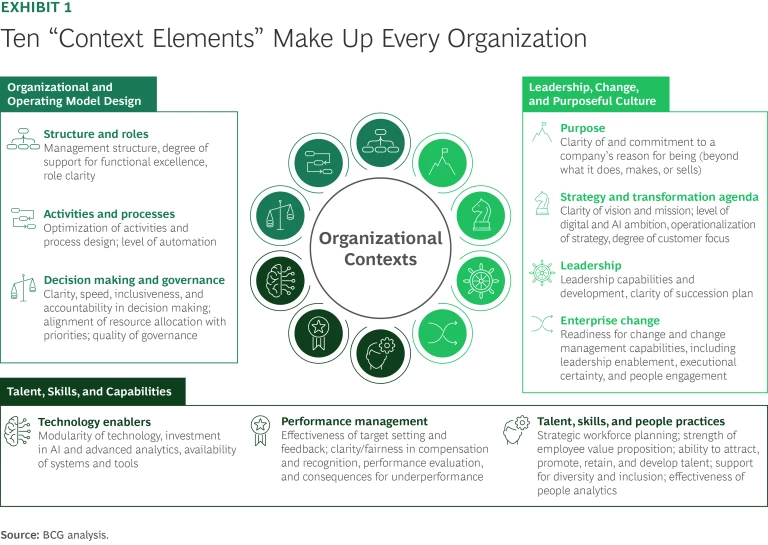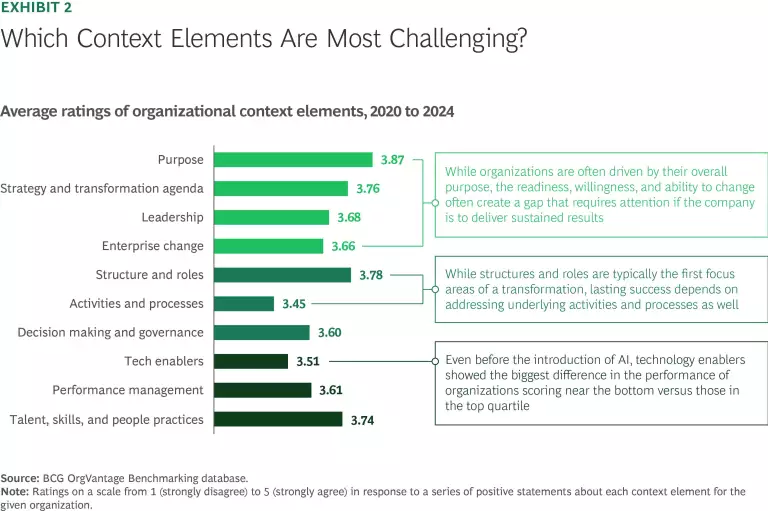Companies around the globe are transforming to improve their financial results, evolve their capabilities, and create organizational advantage. Yet too often, leaders who seek to transform their organizations lack a clear, data-driven understanding of where they’re starting from—making it much harder to achieve their desired outcomes.
A successful transformation doesn’t happen simply through a series of tactical moves. It requires a deliberate plan that aligns strategic actions with an organization’s existing strengths and challenges. Without that foundation, transformations fall short of their full potential.
Focusing on the Right Elements
To gain a clearer understanding of what it takes for organizations to get and stay ahead, we examined ten years of global data from BCG project experience and from OrgVantage, our proprietary diagnostic tool, which allows leaders to evaluate where their organizations stand based on ten prioritized “context elements.” (See Exhibit 1.)

These context elements make up aspects of every business, regardless of sector or industry. In many ways, they form the unique fingerprint of an organization during the steady “run the business” periods. The way that companies prioritize and manage these elements in a transformation becomes even more visible than during regular operations—and often makes the difference between sustainable transformative outcomes and what are simply a series of tactical moves to drive short-term performance.
Stay ahead with BCG insights on people strategy
While a business will likely want to excel across all ten elements, it is unrealistic to focus on all of them at the same time. Instead, the business should prioritize the context elements that will best support its ambitions.
Though our research draws on over a decade of BCG experience and the analysis of more than 150,000 data points, we have concentrated on the past four years of results to identify the elements on which companies consistently underperform. (See Exhibit 2.)

The averages here suggest that some of the most challenging areas involve the elements we call activities and processes, tech enablers, and enterprise change. While these are common pain points, however, organizations should prioritize their focus based on their broader transformation strategy and ambition.
Shaping Organizational Advantage
In recent years, we have partnered with numerous organizations undergoing large-scale transformation. One takeaway is clear: each company must understand the unique context elements that shape its organizational advantages and desired outcomes. Even two similar organizations operating in the same space with comparable ambitions will design distinct approaches for their organizations if they genuinely aim to drive meaningful, sustainable transformation.
The experience of two North American retailers illustrates this point. Both companies have undergone large-scale transformation since the pandemic; still, while similar in geography, sector, and size, each had different starting points and required a focus on different context elements to succeed.
Building Alignment and Accountability. A global apparel retailer outlined a transformation journey designed to create revenue growth and profit opportunities. Early on the journey, the company understood through the OrgVantage diagnostic that, while it had succeeded in establishing a clear transformation vision, it needed to address employee uncertainty about how to balance immediate customer demands with its new long-term business objectives. In addition, the leadership understood it needed to improve the processes that helped employees make critical decisions.
To address these concerns, the company developed interventions for three key context elements that it determined would best support the transformation efforts:
- Strategy and Transformation Agenda. The company clearly communicated its strategic direction and status to affected stakeholders. It prioritized regular check-ins with the entire organization, ensuring alignment between current business realities and transformation objectives.
- Enterprise Change. The company established a transformation office to create a unified and empowered team, driving unwavering accountability to KPIs that were regularly reviewed by the C-suite to demonstrate progress.
- Structure and Roles. The company developed clear alignment to specific transformation objectives through actionable targets for the executive team that were visible to the organization.
As a result, it succeeded in creating clarity and alignment among employees and enhanced its decision-support infrastructure to enable better prioritization and accountability.
Translating Vision into Action. A national retail company was embarking on a transformation journey to leverage its digital tools more effectively and drive revenue growth. Early in the process, it conducted a series of listening sessions, complemented by an OrgVantage diagnostic, to gain a clearer understanding of employee needs and barriers to success.
While employees were highly aligned with the company’s purpose, the data showed the need to translate the leadership’s strategic objectives more clearly into day-to-day actions. Additionally, insufficient alignment in decision-making processes was slowing down execution and creating some ambiguity around accountability.
To address these challenges, the executive team convened senior leaders at an offsite meeting, where they were able to agree on a set of focused interventions to drive clarity and empower teams across three context elements:
- Leadership. The business launched a deliberate push to foster multidirectional dialogue and an open forum for addressing challenges, demonstrating leaders’ vulnerability and commitment to change.
- Decision Making and Governance. The business introduced clearer structures to empower customer-facing teams with greater decision-making authority, supported by defined roles and responsibilities.
- Enterprise Change. The business launched a targeted internal communications strategy to consistently reinforce the enterprise vision and ensure its integration into daily operations across all levels.
Through these moves, the company strengthened its organizational alignment, reinforced employee autonomy, and laid the foundation for a more agile and accountable workforce.
Beginning with Clarity
Many organizations mistakenly assume they have clarity about their organizational strengths and goals based on either their day-to-day experience or on annual engagement surveys. Yet, they are often overlooking gaps between perception and reality, especially in the way work gets done in the company.
To achieve true organizational advantage, their leaders must begin by objectively assessing where their organizations stand today, articulating where they aspire to be, and identifying the critical actions required to achieve that aspiration. Organizations that act intentionally in this regard will avoid blind spots and position themselves for successful change—with sustained results.
The authors would like to thank their colleagues Vikram Bhalla and Paul Catchlove for their contributions to this article.






